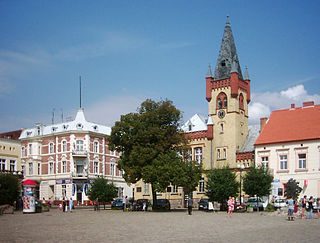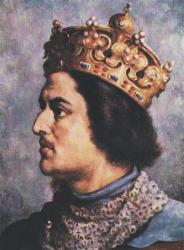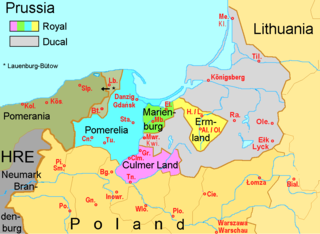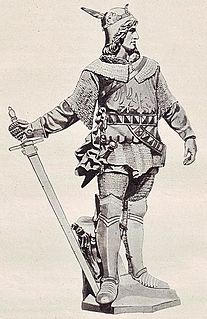The Treaty of Arnswalde (Treaty of Choszczno) was signed on 1 April 1269 between three Brandenburgian margraves, the Ascanians John II, Otto IV and Conrad, and Duke Mestwin II of Pomerelia (Mściwój II) in Arnswalde (then a fortified place in the Brandenburgian New March, now Choszczno, Poland).

The Margraviate of Brandenburg was a major principality of the Holy Roman Empire from 1157 to 1806 that played a pivotal role in the history of Germany and Central Europe.
The House of Ascania is a dynasty of German rulers. It is also known as the House of Anhalt, which refers to its longest-held possession, Anhalt.

John II, Margrave of Brandenburg-Stendal was co-ruler of Brandenburg with his brother Otto "with the arrow" from 1266 until his death. He also used the title Lord of Krossen, after a town in the Neumark.
With the treaty, Mestwin gave some of his possessions to the margraves, and had them returned as a fief. Excluded from the return was the Białogard (Belgard) area, including Świecie (Schwetz), which remained under direct Brandenburgian rule. In turn the margraves financed the duke, e.g. for the marriage of Mestwin's daughter Catherine with Pribislaw II of Parchim-Richtenberg (part of Mecklenburg).

Białogard(

Świeciepronounced [ˈɕfʲɛt͡ɕɛ] is a town in northern Poland with 25,968 inhabitants (2006), situated in Kuyavian-Pomeranian Voivodeship ; it was in Bydgoszcz Voivodeship from 1975 to 1998. It is the capital of Świecie County.

Mecklenburg is a historical region in northern Germany comprising the western and larger part of the federal-state Mecklenburg-Vorpommern. The largest cities of the region are Rostock, Schwerin, Neubrandenburg, Wismar and Güstrow.
Through this treaty, Brandenburg gained direct access to the Baltic Sea.

The Baltic Sea is a marginal sea of the Atlantic Ocean, enclosed by Denmark, Estonia, Finland, Latvia, Lithuania, Sweden, northeast Germany, Poland, Russia and the North and Central European Plain.
The signing of the treaty provoked a rebellion by the nobility of the region who were opposed to the Brandenburgians. Likewise, Mestwin's brother Warcisław of Gdańsk (Danzig), and his uncle, Sambor II took the opportunity to try and depose Mestwin. However, Warcisław died in 1270 while Sambor was defeated with the help of the Polish duke Bolesław the Pious.

Bolesław the Pious was a Duke of Greater Poland during 1239–1247, Duke of Kalisz during 1247–1249, Duke of Gniezno during 1249–1250, Duke of Gniezno-Kalisz during 1253–1257, Duke of whole Greater Poland and Poznań during 1257–1273, in 1261 ruler over Ląd, regent of the Duchies of Mazovia, Płock and Czersk during 1262–1264, ruler over Bydgoszcz during 1268–1273, Duke of Inowrocław during 1271–1273, and Duke of Gniezno-Kalisz from 1273 until his death.
In 1273 Mestwin found himself in open conflict against the margraves who refused to remove their troops from Gdańsk, Mestwin's possession, which he had been forced to temporarily lease to them during his struggles against Warcisław and Sambor. Since the lease had now expired, through this action, the Margrave Conrad broke the treaty and subsequent agreements, in the hopes of capturing as much of Mestwin's Pomeralia as possible. Mestwin, unable to dislodge the Brandenburgian troops himself called in the aid of Bolesław the Pious, whose troops took the city with a direct attack. The war against Brandenburg ended in 1273 with a treaty (possibly signed at Drawno Bridge), in which Brandenburg returned Gdańsk to Mestwin while he rendered feudal homage to the margraves for the Lands of Schlawe and Stolp.

Drawno is a town in Choszczno County, West Pomeranian Voivodeship, Poland, with 2,425 inhabitants (2004). The headquarters of the Drawa National Park are located here.

Homage in the Middle Ages was the ceremony in which a feudal tenant or vassal pledged reverence and submission to his feudal lord, receiving in exchange the symbolic title to his new position (investiture). It was a symbolic acknowledgement to the lord that the vassal was, literally, his man (homme). The oath known as "fealty" implied lesser obligations than did "homage". Further, one could swear "fealty" to many different overlords with respect to different land holdings, but "homage" could only be performed to a single liege, as one could not be "his man" to more than one "liege lord". A similar concept is the bay'ah, a type of oath in Islam.

The Lands of Schlawe and Stolp or Land of Słupsk-Sławno are a historical region in Pomerania, centered on the towns of Sławno (Schlawe) and Słupsk (Stolp) in Farther Pomerania, in present-day Poland.
In a subsequent treaty of 1282, the Treaty of Kępno signed with the Polish duke (later, king) Przemysł II, Mestwin transferred the suzerainty over all of Pomeralia and Gdańsk Pomerania, including Słupsk (Stolp) and Sławno (Schlawe) to Poland. Przemysł took control over the area but was murdered by agents of Brandenburg in 1296. The subsequent conflict over the area led to the Teutonic takeover of Danzig in 1308. [1]

The Treaty of Kępno was an agreement between the High Duke of Poland and Wielkopolska Przemysł II and the Duke of Pomerania Mestwin II signed on February 15, 1282, which transferred the suzerainty over Gdańsk Pomerania (Pomeralia) to Przemysł. As a result of the treaty Przemysł adopted the title dux Polonie et Pomeranie.

Przemysł II, was the Duke of Poznań from 1257–1279, of Greater Poland from 1279–1296, of Kraków from 1290–1291, and Gdańsk Pomerania (Pomerelia) from 1294–1296, and then King of Poland from 1295 until his death. After a long period of Polish High Dukes and two nominal kings, he was the first to obtain the hereditary title of King, and thus to return Poland to the rank of Kingdom. A member of the Greater Poland branch of the House of Piast as the only son of Duke Przemysł I and the Silesian princess Elisabeth, he was born posthumously; for this reason he was brought up at the court of his uncle Bolesław the Pious and received his own district to rule, the Duchy of Poznań in 1273. Six years later, after the death of his uncle, he also obtained the Duchy of Kalisz.

Słupsk(









